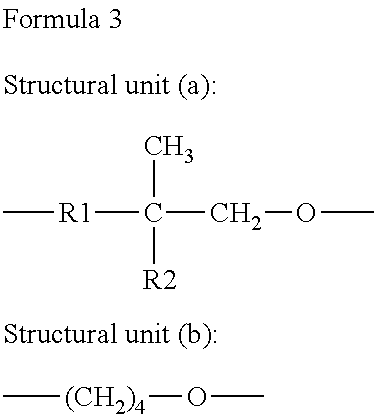Deodorant material
a deodorant and material technology, applied in the field of deodorant materials, can solve the problems of not having an excellent ability to remove and no deodorant material having the capability of removing the odor of nonenal or the distinctive body odor of the middle-aged and elderly has yet been reported
- Summary
- Abstract
- Description
- Claims
- Application Information
AI Technical Summary
Benefits of technology
Problems solved by technology
Method used
Image
Examples
example 1
[0152]As a polyalkylene ether diol, a copolymerized tetramethylene ether diol having a number average molecular weight of 2500 (containing 12.5 mol % of a structural unit (a) derived from 3-methyl-tetrahydrofuran) obtained by the following copolymerization process was used: 87.5 mol of dehydrated tetrahydrofuran and 12.5 mol of dehydrated 3-methyl-tetrahydrofuran were placed in a reactor equipped with a stirrer, and a polymerization reaction was carried out in the presence of a catalyst (a mixture of 70% by weight of perchloric acid and 30% by weight of acetic anhydrides) under a nitrogen seal at a temperature of 10° C. for 8 hours. After the reaction, the resultant product was neutralized with a sodium hydroxide solution to give the copolymer.
[0153]The copolymerized tetramethylene ether diol and 4,4′-MDI were placed in a container so that the amount of 4,4′-MDI relative to 1 mol of the tetramethylene ether diol was 1.97 mol, and the mixture was reacted at 90° C. The obtained produc...
example 2
[0157]The copolymerized tetramethylene ether diol obtained in Example 1 and 4,4′-MDI were placed in a container so that the amount of 4,4′-MDI relative to 1 mol of the tetramethylene ether diol was 6.4 mol, and the mixture was reacted at 90° C. The obtained product was dissolved in DMAc with good stirring to give a solution. Next, to the solution containing the dissolved product, a DMAc solution containing, as a chain extender, 60 mol % of EDA and 40 mol % of 1,2-PDA was added. To this solution, a DMAc solution containing, as an end-capping agent, dicyclohexylamine was further added to give a polyurethane urea solution having a polymer solid content of 25% by weight. The obtained solution at 40° C. had a viscosity of about 5400 poise. The limiting viscosity of the polymer measured in a 0.5 g / 100 ml solution of DMAc at 25° C. was 1.25.
[0158]The polyurethane urea solution was extruded from a spinneret into an inert gas having a high temperature to give four filaments. The filaments we...
example 3
[0179]As a polyurethane fiber having a glass transition point (Tg) of 0° C. or less, the polyurethane urea fiber (B-a) produced in Example 1 was used, and fibers (X) and (Y), both of which contain a carboxyl group were obtained by the following method.
[0180]A diacetate fiber having an acetylation degree of 55% (88 dtex, 24 filaments, manufactured by Mitsubishi Rayon Co., Ltd.) obtained by dry spinning according to a conventional method was graft-polymerized with a solution containing 20.0 g / 1 methacrylic acid, 0.6 g / l ammonium ferrous sulfate, and 0.3 g / l hydrogen peroxide with the use of an Obermaier finishing machine at a bath ratio of 1:40 at 80° C. for 60 minutes Next, the fiber was repeatedly washed alternately with water and hot water. The fiber had a graft rate of about 10% and a concentration of carboxyl group of 320 meq / kg. This fiber was referred to as (X). By the same method as the method mentioned above except that the diacetate fiber had a dtex of 150 and contained 48 f...
PUM
| Property | Measurement | Unit |
|---|---|---|
| Tg | aaaaa | aaaaa |
| surface area | aaaaa | aaaaa |
| elongation rate | aaaaa | aaaaa |
Abstract
Description
Claims
Application Information
 Login to View More
Login to View More - R&D
- Intellectual Property
- Life Sciences
- Materials
- Tech Scout
- Unparalleled Data Quality
- Higher Quality Content
- 60% Fewer Hallucinations
Browse by: Latest US Patents, China's latest patents, Technical Efficacy Thesaurus, Application Domain, Technology Topic, Popular Technical Reports.
© 2025 PatSnap. All rights reserved.Legal|Privacy policy|Modern Slavery Act Transparency Statement|Sitemap|About US| Contact US: help@patsnap.com



